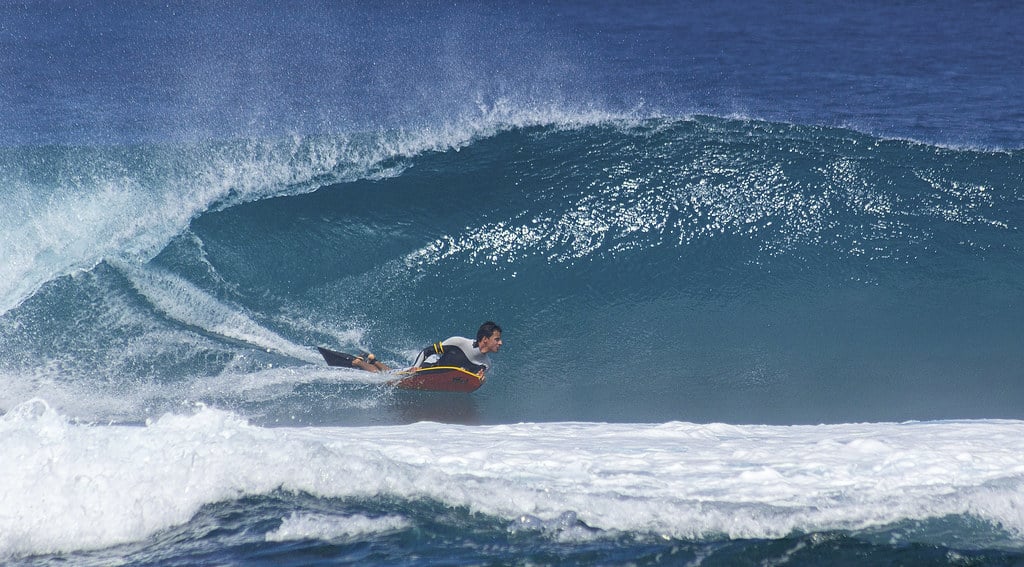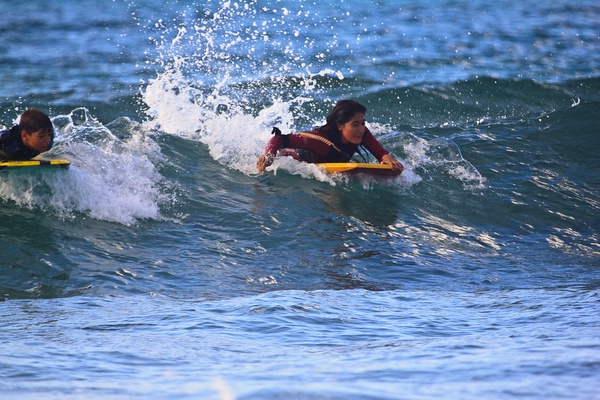We really love Bodyboarding and we think you will too. It’s just so much fun that you will leave the water stoked like never before in your life.
But for whom is bodyboarding essentially the right sport?
And is it hard to learn?
What are the most important tips and tricks to follow right from the start?
What’s the fastest way to catch the first waves and be able to surf?
With every sport, when one is first learning it, it helps to be a bit prepared ahead of time.
In the following short chapters we’ll give you not only the answers to the above questions, but show you the most important mistakes which you should avoid right from the start.
So let’s dive right in!

How to Learn bodyboarding – Tipps for Beginners
Who is Bodyboarding right for? Is Bodyboarding hard to learn?
Bodyboarding is a fine exercise for everyone who likes splashing around in the water and surfing the waves. If you like basking in the sun and taking in the fresh air, you’ll have a blast. If you love the thrill of speed and the exhilaration of just a little bit of danger, all the better.
And remember: Bodyboarding is not really hard to learn and to reach a level at which you really can have fun in the waves is easy. Just start small, consider the tips we’ve given you, and take it step by step.
Of course, if you then plan to ride bigger waves or start learning some tricks, bodyboarding will become more and more of a challenge, and it definitely will never be boring. So, we believe bodyboarding is just the perfect sport for almost anybody.
What you should know for your first time in the waves
Practice a little on the beach before heading out
Practice on the ground before setting out in the water. Put your bodyboard on the ground and attach the leash. Lay on the board so that the center of your body is above the center of the bodyboard. Get a feel for which muscles you’ll be using when in the water. When you are ready to get started, find a part of the beach that isn’t too crowded and go during a time when the waves are smaller.
Bonus – Tip: Do not forget to check the wind. For your first sessions, try not to go out when the wind is blowing offshore.
The first steps in the water
When you have found your spot, just head out slowly into the water. When you are about waist deep, lie on your board and just start kicking. Get used to riding around on the board a bit before you actually try to catch a wave.
When you are comfortable on the board, follow these steps to ride your first wave:
- As the wave approaches, lie on your board facing the beach.
- Start kicking, adding paddling with one or both hands if you are comfortable [1].
- As the wave approaches, you want to enter it before the break, then turn in the direction it is breaking [2].
- Now use the hand that is on the opposite side of the wave to hold the rail of the board while the other hand grips the nose [3].
- Keep your head in the direction you want to ride and enjoy it!



Common Bodyboarding – Mistakes easy to avoid
As always: no master has been ever learned everything in one day! However, we can give you some easy tips which will help you to get more comfortable more quickly.
- Don’t grab at the rail when it is in the water. You will have a hard time maintaining balance and this will create drag underwater.
- Keep your eyes on where you are going. In addition to avoiding obstacles and other people, you want to be aware of where the waves are breaking.
- Respect other people and where they’re headed in the water. Those closest to the wave get the chance to ride it first. Also, ask about any beach–specific rules and dangers, like rip currents, before setting out in the water.
- Don’t rely on just your feet. Paddling with your hands at times can give you extra momentum to better ride a wave.
First Time In the Water: Let the Ocean carry you
You should get comfortable in the water or at least not be afraid of it. The ocean has a mind of its own and a language through which it speaks to every living creature in it, including you. Granted, that language is not as verbose as human languages, but it is just as expressive. You need to listen patiently and feel the ocean rather than just launch yourself into the waves.
Water has considerable weight and force; the ocean has a virtually endless supply of it. If you fight the ocean, you will always lose miserably and have no fun at all.
Don’t resist the water. Instead, let it carry you wherever it may, with you only adjusting your direction a little bit. The goal of bodyboarding is to listen to the ocean, adapt to it ,and ride the waves until you feel your heart fill with freedom and childlike glee.
IMPORTANT Safety Tip:
Check on the specific conditions of every beach where you’re bodyboarding. You need to determine where the rip tides are. If you get caught in a rip tide, remember that it won’t pull you under – only out. Keep calm, float on your board, and kick yourself perpendicular to the shore until you are out of the rip current.
Conclusion
Bodyboarding is definitely a sport for everyone who loves the water and is looking for some thrills. Believe us: there is hardly a better feeling than catching a wave and surfing towards the beach at high speed!
Also, bodyboarding needs comparatively little practice, and you can reach a level quickly where you can already have an incredible amount of fun in the waves.
If you also pay attention to the most important tips from this article, we promise you, you will become a die-hard bodyboarder very quickly!
More helpful information about Bodyboarding
We really hope that you now will explore the thrill of Bodyboarding. If you need more helpful information to get started or to improve your skill level – we’ve got you covered!
Check out our explanatory articles about the most important Bodyboard features like stringers, tail form or or the rail ratio. Or learn everything you need to know about the right size of a Bodyboard, the Bodyboard leash, how to easily install the leash plug and Bodyboard fins.






